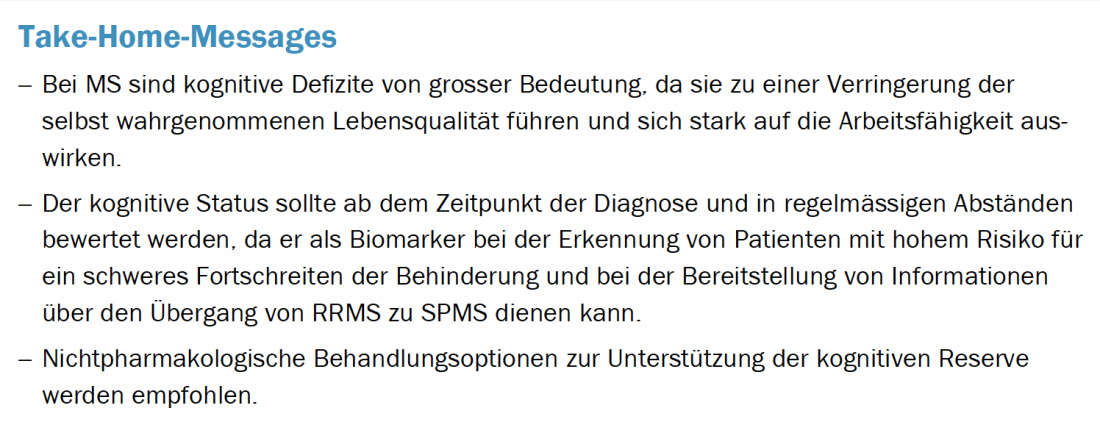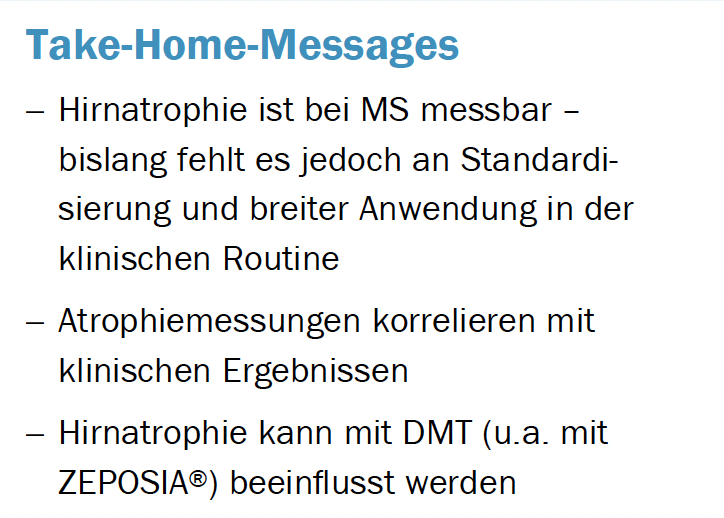Factors such as brain atrophy and cognitive impairment are becoming increasingly important in the care of patients with multiple sclerosis (MS). At a symposium chaired by Prof. Dr. med. Andrew Chan, Bern, Prof. Dr. Dipl.-Psych Iris-Katharina Penner, Düsseldorf, showed how cognitive performance should be recorded and monitored. PD Dr. med. Anke Salmen, Bern, described how modern techniques could help to record the extent of brain atrophy in a standardized and differentiated way. At the beginning of the symposium, Prof. Xavier Montalban, MD, Barcelona, reported on how the COVID-19 pandemic has changed clinical routine at the Catalan MS Center.
Lockdown and scarce human and spatial resources made it necessary for Prof. Xavier Montalban, MD, Barcelona, and his staff to find new ways in 2020 to continue to provide high quality and individualized care to their MS patients. In particular, they make use of the possibilities offered by modern communication technologies.
New ways of care
As Prof. Montalban explained, as a result of the 2020 pandemic, about 40% of all consultations were conducted by telephone or videoconference. “Currently, the percentage of virtual consultations remains at 40 to 45 percent, and we would like to keep it that way in the future,” he explained. The MS Center’s rehabilitation programs were discontinued altogether for a brief period during the first wave of the pandemic and then replaced with tele-assessments and individual or group videoconferencing. “We now know that web-based interventions are equally effective as face-to-face therapies and that patients are equally satisfied with this new type of care,” Prof. Montalban said. “But probably one of the biggest changes COVID-19 has made in the care of our people with MS is that they all receive a vaccination against coronavirus before starting disease-modifying therapy,” the speaker said. Summing up, Prof. Montalban said, “The various virtual measures will certainly not replace personal face-to-face contact, even in the post-pandemic period. But they are a welcome and appreciated addition.”
Specific test for the detection of cognitive deficits
The second speaker of the symposium, Prof. Dr. Dipl.-Psych Iris-Katharina Penner, Düsseldorf, emphasized the importance of cognitive impairment in MS patients: “Cognitive deficits are found in 40 to 50% of patients. Since other neuropsychiatric symptoms of MS – especially fatigue and depression/anxiety – would influence cognitive functions, she said, it is important to consider these factors as well when assessing cognitive performance. “We also know from many studies that all of these symptoms affect the quality of life of people with MS as well as their ability to work,” she emphasized.
The EDSS score is not suitable for assessing cognitive impairment. For example, a study of over 16 000 MS patients showed that even with an EDSS score of 0 to 3, a large proportion of participants had cognitive problems and productivity limitations [1]. Clinical interview, a standard neurological examination, and self-report by the affected individuals are also not sensitive enough to detect cognitive impairment [2,3]. Because cognitive impairment in MS patients leads to specific changes such as a decrease in information processing speed, problems with attention, limitations in short-term memory and learning, and a decrease in multitasking abilities, assessment requires appropriately targeted tests. “Therefore, never use a dementia test to assess cognitive deficits in your MS sufferers,” Prof. Penner emphasized. In contrast, specifically recommended for people with MS is the BICAMS (Brief Cognitive Assessment for MS), which is composed of the SDMT (Symbol Digit Modalities Test), the BVMT-R (Brief Visuospatial Memory Test Revised), and the CVLT-II (California Verbal Learning Test II) [4]. “It takes a total of 20 minutes to perform these tests,” the speaker explained. “If there is not enough time for the entire assessment in practice, only the SDMT and the BVMT-R can be performed. Within 10 minutes, cognitive impairments can be assessed with comparable reliability.”
Repeat collection annually
The cognitive status of patients with MS should be assessed not only once, but regularly (e.g., once a year) from the time of MS diagnosis. “Cognition can thus serve us as a biomarker to identify affected individuals at high risk for disability progression,” Prof. Penner said. An Italian paper found that patients who already had cognitive impairment at the time of MS diagnosis had the most aggressive disease course in terms of disability progression [5]. “In my opinion, this knowledge should also be incorporated into the decision regarding the most appropriate therapy,” the speaker said. A non-systematic literature review found that people with secondary progressive MS (SPMS) showed a greater decrease in information processing speed, assessed by SDMT, and in visual short-term memory and learning (BVMT-R) [6]. “With regular assessment of cognitive performance, a striking decline in these two domains could indicate the onset of conversion from relapsing to SPMS,” Prof. Penner explained. Finally, she pointed out that due to the importance of cognitive deficits for people with MS, the German Society of Neurology advocates a once-yearly cognitive assessment in its national recommendations [7].

New techniques improve detection of brain atrophy
Finally, the lecture of PD Dr. med. Anke Salmen, Bern, dealt with the topic of brain atrophy in MS. Studies have shown that the brain volume of people with MS decreases more over the years than is the case in healthy people as they grow older [8]. “Brain atrophy can be detected in all MS subtypes. However, its extent varies greatly,” she emphasized. Therefore, there are no standardized values available so far, which would allow, for example, to correctly classify the effect of a therapy on brain atrophy.
Gradually, however, new techniques, such as the use of artificial intelligence (AI), are finding their way into the detection and quantification of brain atrophy. “This can be used, for example, to record the extent of brain atrophy in different brain regions and also to show how it changes over a period of time under disease-modifying therapy,” Dr. Salmen explained. In this way, it could also be determined that under treatment with ZEPOSIA® (ozanimod, 0.92 mg once daily) compared with interferon-beta 1a (30 μg i.m. once weekly) resulted in significantly less decrease in total brain volume and cortical gray matter volume and thalamus volume at 12 and 24 months, respectively, in both the SUNBEAM and RADIANCE trials [9–11]. “The effect of ozanimod on cortical gray matter volume was significantly greater than the effect on total brain volume. Without the new techniques, we would not have obtained this relevant information,” the speaker opined. “We also know today that there are limitations in different cognitive functions depending on the brain area affected.” It is therefore all the more important to develop standardized methods for the differentiated detection of brain atrophy that can also be used in clinical routine. Neurofilament light chain serum (sNfL) levels may also play a role. “Follow-up studies showed that the baseline sNfL value correlated with the percentage change in brain volume over five years. The higher the value, the greater the loss of brain volume,” Dr. Salmen described. In the future, it would be conceivable to develop scores composed of markers such as the sNfL and AI-based parameters.

Literature:
- Kobelt G, et al: New insights into the burden and costs of multiple sclerosis in Europe. Mult Scler 2017;23: 1123-1136.
- Kalb R, et al: Recommendations for cognitive screening and management in multiple sclerosis care. Mult Scler 2018;24: 1665-1680.
- Romero K, et al: Neurologists’ accuracy in predicting cognitive impairment in multiple sclerosis. Mult Scler Relat Disord 2015;4: 291-295.
- Langdon DW, et al: Recommendations for a Brief International Cognitive Assessment for Multiple Sclerosis (BICAMS). Mult Scler 2012;18: 891-898.
- Pitteri M, et al: Cognitive impairment predicts disability progression and cortical thinning in MS: An 8-year study. Mult Scler 2017;23: 848-854.
- Penner IK, et al: Neuropsychological and MRI diagnostics in secondary progressive multiple sclerosis. Neurologist 2021 Dec; 92(12): 1293-1301.
- Penner IK, et al: Cognitive disorders in multiple sclerosis. DGNeurology 2021;4: 184-186.
- Giovannoni G, et al: Brain health: time matters in multiple sclerosis. Mult Scler Relat Disord 2016;9 Suppl 1: S5-S48.
- Specialized information Zeposia® (Ozanimod). www.swissmedicinfo.ch, as of July 2020.
- Comi G, et al: Safety and efficacy of ozanimod versus interferon beta-1a in relapsing multiple sclerosis (SUNBEAM): a multicentre, randomised, minimum 12-month, phase 3 trial. Lancet Neurol 2019;18 (supplementary appendix): 1009-1020.
- Cohen JA, et al: Safety and efficacy of ozanimod versus interferon beta-1a in relapsing multiple sclerosis (RADIANCE): a multicentre, randomised, 24-month, phase 3 trial. Lancet Neurol 2019;18 (supplementary appendix): 1021-1033.
Literature on request
Abbreviated Summary of Product Characteristics Zeposia® (Ozanimod) ▼ This drug is subject to additional monitoring. For further information, please refer to the ZEPOSIA® technical information sheet. at www.swissmedicinfo.ch. I: Indicated for the treatment of adult patients with relapsing-remitting multiple sclerosis (MS). D: Hard capsules 0.23/0.46/0.92 mg orally once daily. Dosage titration schedule: day 1-4: 0.23 mg; day 5-7: 0.46 mg; from day 8: 0.92 mg. AI: Hypersensitivity to active/excipient ingredients; do not start treatment in patients who have had the following conditions in the last 6 months: Myocardial infarction, unstable angina, stroke, transient ischemic attack, decompensated heart failure requiring hospitalization, Class III/IV heart failure, and in patients with a history of or current second-degree (Type II) atrioventricular (AV) block, third-degree AV block, sinus node syndrome (without a functioning pacemaker); severe untreated sleep apnea; immunodeficient state; patients at increased risk for opportunistic infections; severe active infections or active chronic infections (hepatitis, tuberculosis); active malignant disease; severe hepatic insufficiency; existing macular edema; pregnancy. WH/VM: Before initiating therapy: cardiac examination (ECG), liver function test, BB, ophthalmologic examination in patients with diabetes mellitus, uveitis, or a history of retinal disease, check concomitant medications. A transient decrease in heart rate may occur during the first Zeposia® administration; monitoring is recommended in patients with pre-existing cardiac disease. Elevations of aminotransferases are possible. Zeposia® has an immunosuppressive effect that predisposes patients to risk of infection. Test large BB regularly during treatment. If total lymphocyte count is confirmed < 0.2 x109/l Discontinue treatment. Vaccination against VZV of patients without documented immunity recommended 1 month before onset; ophthalmologic examination of patients with macular edema symptoms. Monitor blood pressure regularly during treatment. UW: Very common (10%): Nasopharyngitis. Common (1%, < 10%): Pharyngitis, viral respiratory infection, urinary tract infection, lymphopenia, bradycardia, hypertension, orthostatic hypotension, alanine aminotransferase elevated, gamma-glutamyltransferase elevated. P: Zeposia® starter pack: 7 hard capsules (4 x 0.23 mg, 3 x 0.46 mg); Zeposia®0 .92 mg: 28 hard capsules. Dispensing Category B. Complete technical information available at www.swissmedicinfo.ch. Bristol-Myers Squibb SA, Hinterbergstrasse 16, CH-6312 Steinhausen. Status of information: July 2020.
Imprint
Text: Dr. Therese Schwender, Editor: Leoni Burggraf
Source: Rethinking Routines in Multiple Sclerosis Management Satellite Symposium. Annual Meeting of the Swiss Neurological Society (SNS), November 18, 2021, Interlaken.
© Prime Public Media AG, Zurich 2022
2084-CH-2200002, 01.2022











